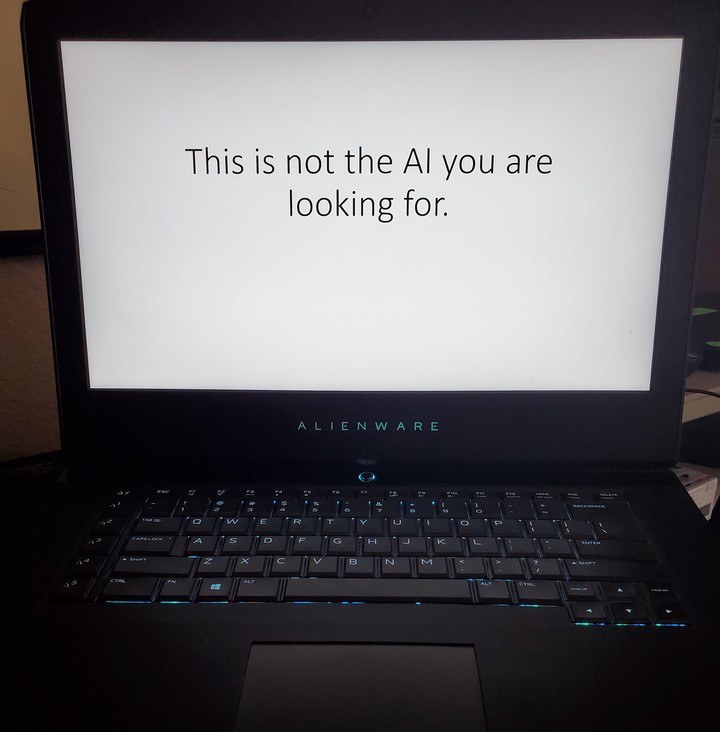What is Machine Learning?
Part 1 AI is not the same as machine learning.

This being my first blog post, ever, I thought I might tackle the subject of Machine Learing vs. Artificial Intelligence.
So, the main problem is that many people use these terms interchangeably. None of which are reading this right now - You did, after all, browse to a website entitled “Ye Olde Machine Learning Shoppe”. I expect that most of you already have some prior knowledge…ok, maybe a little bit? Well, except for you, John - I see you hiding in the back! (It’s ok, all are welcome here, even if you see an airplane flying and think “Hey, Magic!”.)
The truth is that Machine Learning and Artificial Intelligence are QUITE different concepts. What I mean by this is that Machine Learning is not AI. It doesn’t lead to it. It will never BE AI. Simple. BLOG DONE.
Ok, fine. Those of you who take the middle ground, I hear you. No need to shout. I wasn’t actually going to leave it there. And you have a point. Maybe Machine Learning IS AI. Kind of. In a way.
Let’s define terms: Machine Learning involves machines learning something. And AI is machines thinking… wait, what? The astute among you might notice that these two definitions are incomplete. But, alas, we have John with us (And no, I don’t mean you John, I mean the other John - yah, John, right behind you - You see him there don’t you?) Soooo, let’s talk about this.
Artificial Intelligence is a machine that can think and has near-human abilities to reason (but not cry!). Commonly, in today’s world this is referred to as General AI. But there is no way that anything computers can do today can reasonably called General AI. Machines are very good at very specific types of high level “thinking”. Like playing Chess. Or beating the World Go Champion. Or recognizing a face. Or doing my taxes. But one AI has a hard time doing all four. I won’t delve into the reasons for this but it has to do with the their inability to recognize context and make intuitive leaps out of context into other contexts. Or learn from a relatively small amount of data (“One-Shot Learning”). Among other things. I think.
So what we’re really discussing is Activity Specific AI. Which humans have been very good at getting machines to do. In certain types of problems. Like Chess. (Which took a long, long, long, long time for humans to actually get a machine to do, by the way…) What it takes to make this type of specific AI is a whole lot of math and a little bit of simple, rule-based logic.
SIDE NOTE: For a certain subset of you computer scientists out there, yes, I know, you are AWESOME. There all kinds of AI systems that you have invented that rely on NO math whatsoever. To which, I must say, please calm down. Let’s just say, for sake of argument, that there is a lot of math in what you do. Whether you build a list of rules or a decision tree or **gasp** a Finite State Machine (math).
Now, we’re talking about a very specific type of “AI” (which really isn’t AI, but more like instructions to get a machine to do a particular thing using math and logic-based rulesets). Can everyone agree?
Then Machine Learning is how machines build those rulesets and logic, using math and data, in order to drive specific AI (which isn’t really AI). So at best, Machine Learning is a sub-set of what we know as AI in today’s world. But, as we’ll see in future blog posts, what people call “Machine Learning” can also really be thought of as pattern recognition using algorithms. Classificaiton of things. Grouping of things. Math. And it can be done with various amounts of human interaction with the machine. From completely “supervised” learning, like rules sets or Deep Neural Networks (Also known as Deep Learning), along the spectrum to completely “un-supervised” learning, like K-Means clustering. And plenty of techniques along the way. But, I digress.
To sum up: Machine Learning (and, yes, “statistical” learning is a part of the broad bush stroke I am applying here. Stop being a purist!) is math. It can be thought of as a subset of todays so-called “AI”. And AI, as we know it today, really isn’t AI. Clear?
Machine Learning takes a lot of data, catagorizes it, sums it up, tells the machine something about that data. Learns from it. Which, in a way, is a part of AI (again, not General AI, but the fake AI - the thing we think is AI when our phone tells us “That’s your fingerprint! Yay!” and we think its so smart.)
Machine Learning, in industry today, is also thought of as a process or a pipeline. Because, quite frankly it takes boat loads of data to make even reasonable inferences on most problem sets. (Or does it?) Not to mention, these algorithms are completely useless if they can’t be made into an app on someone’s device, right? (Is that really a dog dancing a jig? Click here! - Gotcha!) We’ll also explore these thoughts in future blog posts.
For now, all that I ask is, if you practice data science, if you work with those who practice data science, if you think that machine learning is a magical black box (How does it stay in the air?), please be specific with your words. Machine Learning is all about the math and letting a machine figure out what something is (That’s an elephant.) AI is a far broader term involving robots who rule the earth.
If you liked this discussion, please drop a comment, refer a freind, or email us! (We do like email.) And don’t hold back. I love to learn and I’m not afraid to admit when I get something wrong.
Cheers!